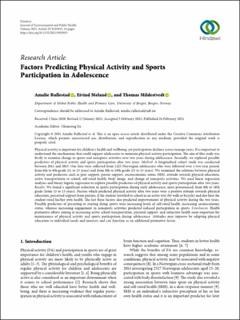| dc.description.abstract | Physical activity is important for children’s health and wellbeing, yet participation declines across teenage years. It is important to understand the mechanisms that could support adolescents to maintain physical activity participation. The aim of this study was firstly to examine change in sports and nonsports activities over two years during adolescence. Secondly, we explored possible predictors of physical activity and sports participation after two years. Method. A longitudinal cohort study was conducted between 2011 and 2013. Our data were collected from 1225 Norwegian adolescents who were followed over a two-year period, from 6th to 8th grade (11 to 13 years) and from 8th to 10th grade (13 to 15 years). We examined the relations between physical activity and predictors such as peer support, parent support, socioeconomic status (SES), attitude towards physical education, active transportation to school, self-rated health, body image, and change of nonsports activities. We used linear regression analyses and binary logistic regression to explore possible predictors of physical activity and sports participation after two years. Results. We found a significant reduction in sports participation during early adolescence, most pronounced, from 8th to 10th grade (from 13 to 15 years). Factors which predicted physical activity after two years were a positive attitude towards physical education, perceived support from parents, if the student travelled to school in an active way (by walk or bicycle) and also how the student rated his/her own health. The last three factors also predicted improvements of physical activity during the two years. Possible predictors of persisting or starting doing sports were increasing levels of self-rated health, increasing socioeconomic status, whereas increasing engagement in nonsports activities predicted reduced participation in sports. Conclusion. Health promotive efforts aiming at increasing active school transportation, parental support, and subjective health seem important for maintenance of physical activity and sports participation during adolescence. Attitudes may improve by adapting physical education to individual needs and interests and can function as an additional promotive factor. | en_US |

